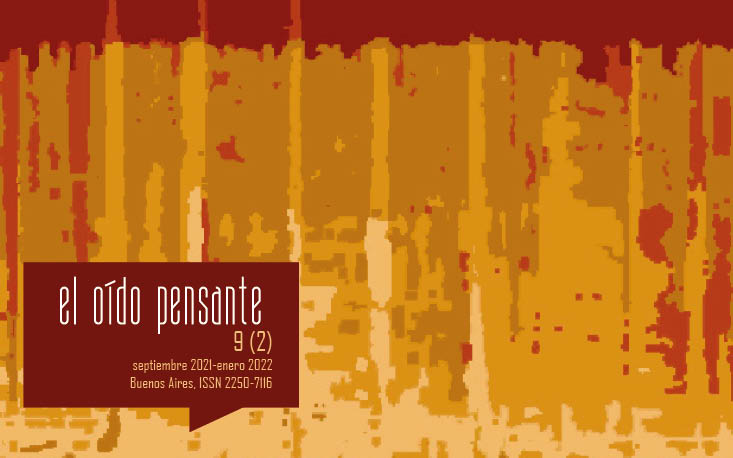El otro en la música que suena: explorando las interacciones de segunda persona en la improvisación de jazz
Resumen
La interacción entre los músicos ocupa un lugar central en la improvisación en jazz; tanto es así que los músicos la señalan como una forma de conversación musical (Monson, 1986). Se abordan aspectos interactivos que son particularmente especiales en la improvisación a la luz de la Perspectiva de Segunda Persona (Pérez y Gomila, 2021), teoría que atiende a los involucramientos emocionales y a las atribuciones directas de intencionalidad en la interacción humana. Partiendo de una experiencia en la que dos grupos de improvisadores tocan juntos un estándar, se entrevista a cada uno de ellos. A partir del análisis cualitativo (Strauss y Corbin, 1998) se indaga en aquellas descripciones relativas a la interacción. Las categorías resultantes en diálogo con la teoría nos ayudan a comprender cómo los improvisadores atribuyen intenciones de manera recíproca durante su hacer. Se explicita cómo los músicos hacen propia la idea del otro, su sonido y corporalidad. La improvisación jazzística se construye en diálogo con la intención del otro, intención que puede ser acompañada, reforzada, discutida, incluso no compartida. La propia intención musical toma forma en el encuentro con la intención del otro en la música que suena.Descargas
Citas
Berliner, P. (1994) Thinking in Jazz. The Infinite Art of Improvisation. Chicago: University of Chicago Press.
Español, S. (2010): Performances en la infancia: cuando el habla parece danza, música y poesía. Epistemus, nº 1, pp. 57-95. doi.org/10.21932/epistemus.1.2702.0
Gomila B. A., y Pérez, D. (2018). Mental Attribution in Interaction: How the Second Person Perspective dissolves the Problem of Other Minds. Daimon. Revista Internacional De Filosofia. 75. doi:10.6018/daimon/332611
Gomila, A. (2002). La perspectiva de segunda persona de la atribución mental. Azafea: Revista de Filosofía, 4, 123-138.
Gratier, M. (2008). Grounding in musical interaction: Evidence from jazz performances. Musicae Scientiae, 12(1, Suppl.), 71–110. doi:10.1177/1029864908012001041
Johnson, M. (2007). The meaning of the body. Aesthetics of human understanding. Chicago, Estados Unidos: The University of Chicago Press.
Leman, M. (2011). Cognición musical corporeizada y tecnología de la mediación (Traductores Martínez, I. C., Herrera, R., Silva, V., Mauleón, C. y D. Callejas Leiva). Buenos Aires: Sociedad Argentina para las Ciencias Cognitivas de la Música (2008).
Leman, M. (2016). The Expressive Moment. How Interaction (with Music) Shapes Human Empowerment. Massachusetts, Estados Unidos: The MIT Press.
Maloch, S. y Trevarthen, C. (Eds.) (2009) Communicative musicality: exploring the basis of human companionship, Oxford, Oxford University Press.
Martínez, I. C. (2008). Cognición enactiva y mente corporeizada: el componente imaginativo y metafórico de la audición musical. Estudios de Psicología, 29(1), 31-48. doi:10.1174/021093908783781419
Martínez, l. C. y Español, S. (2009): lmage-schemas in intuitive parental performance, en Louhivuori,J.; Eerola, T.; Saarikallio, S.; Humberg, T. y Eerola, P.-S. (eds.), Proceedings of the 'J'h Triennial Conference of ESCOM, Jyvaskyla, pp. 297-305.
Martínez, I. C. (2014). La base corporeizada del significado musical. In S. Español, Psicología de la música y del desarrollo. Una exploración interdisciplinaria sobre la musicalidad (pp. 71-110). Buenos Aires (Argentina): Paidós.
Martínez, I. C., Damesón, J., Pérez, J., Pereira Ghiena, A., Tanco, M. y Alimenti Bel, D. (2017). Participatory Sense Making in Jazz Performance: Agents’ Expressive Alignment. 25th Anniversary Conference of ESCOM: The expressive interaction with music. Gent: European Society for Cognitive Sciences of Music.
Monson, I. (1996) Saying Something: Jazz Improvisation and Interaction. Chicago: The University of Chicago Press.
Pérez, D. (2013). Sentir, desear, creer. Una aproximación filosófica a los conceptos psicológicos. Buenos Aires, Ed. Prometeo.
Pérez, D., y Gomila, A. (2021). Social cognition and the second person in human interaction. London: Routledge.
Pérez, D. y Lawler, D. (2017) La segunda persona y las emociones. Ed. SADAF. Buenos Aires.
Pérez, J.B. (2015) Interacción en la improvisación jazzística: El análisis de los aspectos rítmicos en el ciclo de percepción-acción. Percepta. 2(2) (95-110). Asociacion Brasileira de Cognição e Artes Musicais.
Pérez, J.B. (2016). Improvisar en Jazz: Un estudio psicomusicológico de la improvisación con músicos argentinos. [Tesis doctoral inédita]. Facultad de Artes, Universidad Nacional de La Plata. doi:10.35537/10915/52468
Pérez, J.B.; Tanco, M.; Martínez, I.C.; Alimenti Bel, D.; Dameson, J.; Pereira Ghiena A. (2017). La construcción del sentido participativo en la música: dinámicas de interacción ‘orientador-orientado’ en la improvisación jazzística. En N. Alessandroni y M.I. Burcet (Eds.), Actas del 13º Encuentro de Ciencias Cognitivas de la Música (pp. 350-360). Buenos Aires: SACCoM.
Pérez, J.B., y Martínez, I. C. (2020). Encontrarnos en la performance. Epistemus. Revista De Estudios En Música, Cognición Y Cultura, 8(2), 021. doi.org/10.24215/18530494e021
Reddy, V., y Morris, P. (2004). Participants Don't Need Theories: Knowing Minds in Engagement. Theory & Psychology, 14(5), 647–665. https://doi.org/10.1177/0959354304046177
Reddy, V. (2008). How Infants Know Minds. Cambridge, MA: Harvard University Press.
Sawyer, K.R. (2003). Group creativity: Music, theatre, collaboration. Mawah, NJ: Lawrence Erlbaum.
Schogler, B. (2002). The pulse of communication in improvised jazz duets. Tesis Doctoral no publicada, The University of Edinburgh, U.K.
Scotto, C. (2002). Interacción y atribución mental: la perspectiva de la segunda persona. Análisis filosófico, 22(2), 135-151.
Strauss, A. L., & Corbin, J. (1998). Basics of qualitative research: Techniques and procedures for developing grounded theory (2nd ed.). Thousand Oaks, CA: SAGE.
Trevarthen, C. (1999). Musicality and the intrinsic motive pulse: Evidence from human psychobiology and infant communication. En Musicae Scientiae (Special Issue 1999–2000), 155–215.
Walton, A.; Washburn, A.; Langland-Hassan, P.; Chemero, A.; Kloos, H.; Richardson, M. (2017). Creating Time: Social Collaboration in Music Improvisation. Topics in Cognitive Science. doi:10-1111/tops.12306























